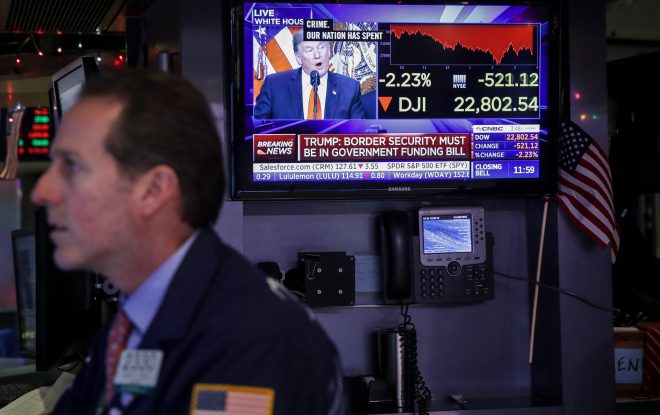Fed rate cut decision risks investor 'angst' — here's what strategists are saying
With the Federal Reserve poised to start cutting interest rates Wednesday, investors cautioned against policy “angst,” calling for a gradual easing cycle to build confidence in the economy.
Speaking at the Future Proof festival in California, David Kelly, chief global strategist for JPMorgan Asset Management, said the central bank risked “freaking people out” by being too hawkish.
“If they cut rates aggressively here, they’re going to undermine confidence,” Kelly said in an interview with Yahoo Finance. “It’s kind of like lowering a piano down from the fourth floor of the building. You’ve got to do it slowly and carefully.”
The FOMC meeting is set to officially bring an end to a years-long tightening campaign to cool inflation, marking a significant shift in policy. The most recent Consumer Price Index (CPI) showed prices increased 2.5% year on year in August, the slowest rate of increase since 2021, putting inflation within reach of the Fed’s 2% target.
But Wall Street has remained divided on how aggressively the Fed should move to protect the labor market and avoid a recession — and on whether to cut interest rates by 25 or 50 basis points. Kelly struck an optimistic tone, saying that while growth is likely slow, the risks of a significant economic downturn remain low.
“In the end, you’ve got to give me a reason why consumers stop spending, and I think it takes a lot to make American consumers stop spending,” Kelly said.
Retail sales data released Monday pointed to the relative resilience among consumers. Sales increased unexpectedly in August by 0.1%, while the July data was revised up to 1.1%. That comes as the labor market starts to show signs of slowing, as the US economy added fewer jobs than expected in August.
Saira Malik, president of Nuveen equities and fixed income, said the cycle of high inflation and interest rate increases will eventually hit the consumer. She forecasts an economic recession “sometime” in 2025.
“We are definitely cautious,” Malik said at Future Proof. “Look at history. Employment markets tend to crack right when a recession starts, so you cannot depend on employment telling you when a recession is coming.”
Bryan Whalen, chief investment officer at TCW’s fixed income group, echoed those sentiments. The Fed’s policy shift may defer a downturn in the economy, but it’s unlikely to prevent it, he said.
“Whether it’s going to be a mild recession or a moderate recession, I think a lot of that’s going to be determined by the Fed reaction function, how bad things get,” Whalen said. “Does something break in the capital markets? And then how do they react from a rate and a [quantitative easing] perspective? That will determine how deep this goes.”
Investors reassess portfolios for a new interest rate environment
The climb in interest rates over the past couple of years has driven big demand for cash and short-term assets, including things like CDs and short-term bills. The strategists at Future Proof said now is a good time to take a second look at that positioning as the Fed prepares to cut rates.
“Reinvestment risk is now an investor’s biggest problem and biggest threat,” said Lauren Goodwin, chief market strategist at New York Life Investments.
Read more: What a Fed rate cut would mean for bank accounts, CDs, loans, and credit cards
Callie Cox, chief market strategist at Ritholtz Wealth Management, told Yahoo Finance in an interview that investors need to keep an eye on falling rates: “We’ve obviously seen the 10-year yield move from 4.7% to 3.7%. We’re saying lock in rates now and understand why you’re holding cash where you are.”
Cox is counseling clients to shift their portfolios.
“Now is the time to invest in risk assets, especially if you’re a long-term investor and you can handle some swings that we see,” she said. “At the same time, prepare for a recession. Have a game plan ready.”
The traditional portfolio allocation of 60% invested in stocks and 40% invested in fixed income has long been debated by investors and the registered investment advisers who made up most of the Future Proof conference attendees.
Malik and Goodwin said the template can — and should — be tinkered with.
“We’re looking at balancing, for example, large-cap equity, where we’ve seen a lot of the gains manifest over the past couple of years, with lower- or middle-market private equity as an opportunity to balance a portfolio,” Goodwin said. “Be creative within that 60-40 benchmark.”
Malik went further, saying, ”The 60-40 evolves to a 50-30-20,” meaning 50% equities, 30% fixed income, and 20% alternatives.
Kelly also noted that after periods of outperformance — like in the last decade — the returns from the 60-40 wane.
“You have to have the discipline to add international to a portfolio because we do think that in the long run that will give you better returns,” Kelly said. “Also look at alternatives — things like infrastructure, transportation, some areas of real estate, if you can find the right manager.”
Whalen, as chief investment officer of TCW, a fixed-income giant, made a case for bonds no matter the economic backdrop from here.
If the Fed succeeds in averting a recession, he said, “your investment-grade corporate bond fund is probably going to return you plus or minus 5%. That’s not bad.”
Click here for in-depth analysis of the latest stock market news and events moving stock prices
Read the latest financial and business news from Yahoo Finance




Leave a Reply